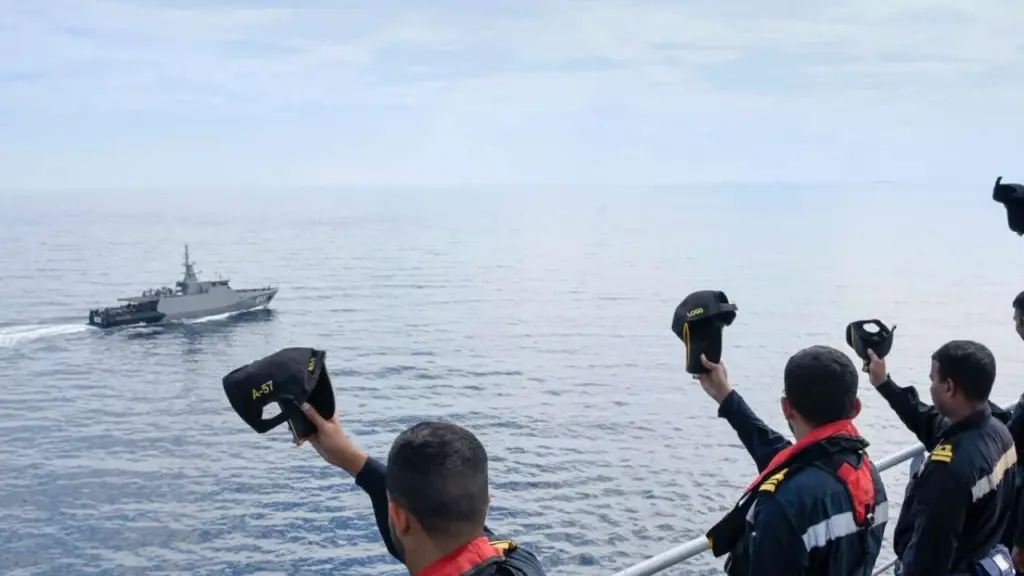On September 23–24, 2020, the Indian Navy (IN) and Royal Australian Navy (RAN) held a Passage Exercise (PASSEX) in the East Indian Ocean Region.

The exercise, aimed at developing mutual familiarization and interoperability between both navies, was a historical milestone towards intensifying India and Australia’s defense cooperation.
A Summary Passex Exercise 2020
Several large naval ships of both countries participated in the PASSEX exercise. The RAN was represented by guided missile destroyer HMAS Hobart on behalf of Australia.
The Indian Navy was represented by two ships, INS Sahyadri and INS Karmuk. Helicopters from both navies, as well as an Indian Maritime Patrol Aircraft (MPA), also participated in the exercises.
In addition to improving the operational effectiveness of the two navies, the objective of this uncommon exercise was to increase cooperation between the two navies. The exercises testified to the professionalism and capability of the two naval forces and included sophisticated surface and anti-air operations.
The Aims of Passex Exercise
The major aims of the PASSEX exercise were to:
• Improve Interoperability: The main aim of the combined exercises was to make the two navies able to operate together under actual circumstances.
• Improve Understanding: By the exchange of tactics and strategies that contribute to overall naval performance, the exercise gave sailors from both nations a chance to learn from one another.
• Learn from One Another: The two navies sought to find best practices that can be applied to future operations through observing and taking part in various drills.
Activities in the Exercise
The PASSEX exercise 2020 entailed a series of activities designed to test and improve the operational readiness of the two navies. Some of the most important activities included:
• Advanced Surface Maneuvers: The navies conducted manoeuvres intended to test surface warfare tactics, including ship movement and coordinated action.
• Anti-Air Drills: Through rehearsals on how to defend against air attacks, the two navies were better placed to react to whatever situation arose.
• Firing of Weapons: To demonstrate the proficiency of naval systems and crew efficiency, live weapon firings were conducted.
• Seamanship Exercises: The exercises were dedicated to the ship handling and navigating skills necessary to ensure safe and productive ship handling and navigation.
• Cross Deck Flying Operations: In order to demonstrate their capability for coordinating air cover and flying operations together, the two navies conducted cross-deck flying operations.
The Importance of Passex Exercise 2020
The mutual fine relationship between the Royal Australian Navy and the Indian Navy is well-supported by the PASSEX exercise. It shows that both nations are willing to remain close to one another in an attempt to safeguard international commons conventions and ensure the safety of the maritime area.
The exercise is part of a larger effort to strengthen Australia-India defense relations. Both governments prefer cooperation to address regional security challenges, especially in the Indo-Pacific region where maritime security is becoming ever more significant.
Building a Strong Connection
Routine exercises and bilateral interactions between the Royal Australian Navy and the Indian Navy have fortified their relationship. Besides boosting the operational capabilities of both forces, these routine cooperative exercises also boost mutual trust and understanding between the two nations.
Sustained exercises like PASSEX are necessary to maintain high readiness and the ability of both navies to react effectively against any maritime threat. Stability and security within the region depend on this ongoing collaboration.
In Conclusion
One of the important milestones in the defense cooperation of India and Australia was the PASSEX exercise held in September 2020. The exercise goes a long way in fostering a more secure and safer maritime order in the Indo-Pacific region through increased understanding and communication between the two navies.
The two countries reaffirm their commitment to cooperating in the face of emerging security challenges as they further strengthen their naval relationship.







